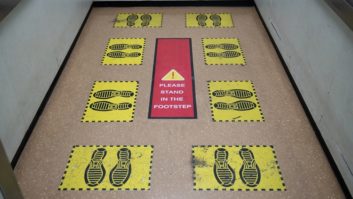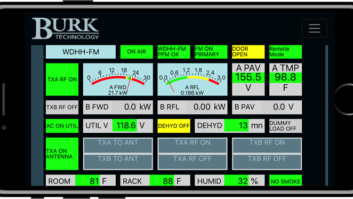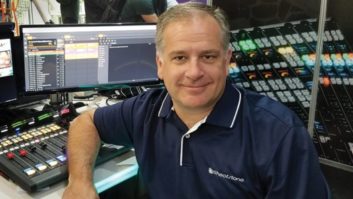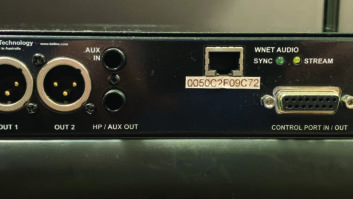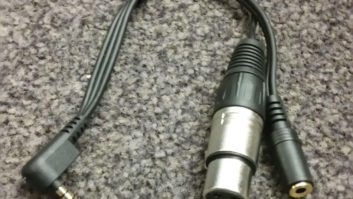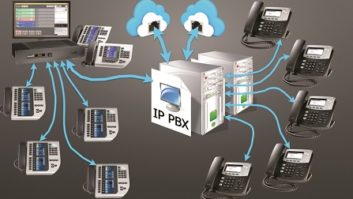On-air Telephone Interfaces
Apr 1, 2008 12:00 PM, By Tom Hartnett
Radio broadcasters rely heavily on their telephones. Whether used for news, interviews, contests, requests or talk radio, the ability to easily manage phones on-air is a long-standing requirement, and that’s unlikely to change. As technical director of Comrex, I’ve had a long-time understanding of the state-of-the-art in this domain and that was only enhanced by Comrex’s acquisition of the Gentner line of telephone interface equipment in 2002. I’ll describe here the current paradigm in telco interface and introduce where this stuff is heading = and it’s heading there fast.
Hybrids aren’t just electric cars

Fig. 1. Analogies of the various methods of providing a communications link
The essential piece of studio telephone integration is the telephone hybrid. As shown in Fig. 1, the two-wire nature of the local telephone loop necessitates that the conversation back and forth must take place over the same circuit. Fig. 1A shows this as being analogous to two people speaking into a single tube. The downside of this arrangement is that each speaker will hear himself echoed in the tube louder than he’ll hear the far end speaker.
Fig. 1B is closer to reality, showing the telephone network as separating the send and receive channels. But in the case of analog phone lines, these are reconverted to a single two-way circuit for delivery to the customer. In both the 1A and 1B scenarios, a hybrid must be used to convert the studio-side, two-wire circuit back to four-wire for use on-air. The output of a hybrid will consist of only caller audio, with all the host audio digitally subtracted from this output. It can be assumed with modern digital hybrid circuits that any remaining host audio is more than 20dB below that of the caller. Lack of a proper hybrid arrangement will result in studio host audio coloration since the hybrid feed-through will add with the main host microphone in the console and produce an effect often described as talking into a barrel. It’s important to note that the main function of these systems is not to alter the send audio, remove garbage audio introduced by poor quality telephones or even far-end echo, but simply to keep the host audio unmolested by telephone feed-through.
Fig. 1C shows the best possible scenario, a four-wire connection at the studio side that keeps a completely independent path in each direction. In this case the actual hybrid function (two-to-four wire conversion) is not required to provide studio send-receive isolation. This is typical of systems that utilize ISDN, T1 or voice over IP (VoIP) interfaces at the studio (more on that later).
But the term hybrid has come to mean much more than this conversion. Telephone feeds suffer from noise and hum, as well as widely varying caller levels (especially these days due to use of poor quality cell phone microphones). So it’s essential that a hybrid (whether it utilizes a two or four wire interface) contain line filtering and AGC to combat these evils. Also, a talk-show host may want to dominate a conversation, so some kind of ducking function is required, detecting host voice activity and reducing caller audio level to a more submissive level.
Call management systems
Taking the concept further, once you move beyond one or two phone lines, you’ll need the call management capabilities of a multi-line (or talk show) system. This typically consists of a mainframe that connects to the telephone lines, and one or more control surfaces to answer, park, screen and put calls on-air. In addition, studios taking callers will need some kind of screening capability to talk to callers in advance and inform on-air talent of their intentions. A block diagram of such a system is shown in Fig. 2.

Fig. 3. A Web-based call screener page display
Modern trends in these systems revolve around enhancing remote control capability. Higher-end talk show systems will include the ability to put these capabilities on a Web page, and this will usually combine the remote control and screening functions. The Comrex STAC talk show system’s Web-based screening page is shown in Fig. 3, which is delivered by a Web server built into the mainframe of the unit. By use of a Web browser, calls can be screened and routed from any location that has Internet access, including remote broadcasts. Also, this removes the requirement for the client computer to have any specialized software installed to view and control the system. Multiple locations can monitor the caller queue and screening information as they listen to the show.
Additional features offered by some screening software may include reflection of caller ID information and logging screening information into a database.
Interface options
Many options are available to deliver multiple on-air phone lines. BRI-ISDN lines are certainly useable as voice lines, and have the advantage of pre-separated send and receive paths. Telos Systems has pioneered use of these for talk show systems with much success. But in my view the long-term outlook for BRI-ISDN service is uncertain, as fewer and fewer non-broadcast applications require it.
As the number of phone lines brought into a facility increases, the cost-benefit tips toward a multiplexed digital delivery such as T1 or PRI-ISDN. For maximum flexibility with use on the widest range of telco interface equipment, individual lines from the T1 may be converted back to analog POTS lines in the channel bank. While effective, this approach isn’t entirely elegant, since you are intentionally introducing an additional digital-to-analog as well as a four-to-two wire conversion that must be reversed by the hybrid within the talk show system. The market for direct-interface T1/PRI broadcast telephone integration is dominated by the higher-end Telos 2101.
On-air Telephone Interfaces
Apr 1, 2008 12:00 PM, By Tom Hartnett
VoIP is the future
The final option for telephone interface isn’t delivered by a phone line at all. The concept of VoIP (Voice over IP) is gaining popularity quickly, and in some instances broadcasters aren’t having much choice in the conversion.
The generic term VoIP can have two meanings. First, it can refer to traditional analog lines brought to a station’s demarcation point, then converted to IP telephony for use over a PBX system. In this instance there usually isn’t much benefit for the broadcaster to make this conversion = it’s better to grab the broadcast lines at the demarc and route them to the studio interface equipment in the traditional way. This isn’t always possible in an environment like a college campus, where an entire Centrex-style system is likely to be replaced by a VoIP network, and access to legacy lines is unreasonable.

The Telos 2101 can access BRI-ISDN and PRI-ISDN lines for on-air use.
The second meaning of VoIP is direct access to a VoIP service provider over an Internet trunk. Services such as Vonage and Broad Voice can offer significant savings over traditional telcos, offering full-featured phone service at less than $10/month in some cases, especially if the lines are used primarily for incoming calls.
The good news is that after years of incompatible VoIP standards, both types of VoIP circuits are converging to follow the SIP protocol, which removes most incompatibilities between hardware and providers. This means that whether you’re programming your SIP-compatible device as a PBX extension or a direct interface to your provider, setup is the same.
Challenges with VoIP
While it has cost advantages, VoIP interface is not always without peril. If you are subscribing to a low-cost provider via DSL or cable modem Internet connection, that link will be provided without QoS (quality of service), meaning that other Internet traffic on the local LAN or within the Internet at large can cause the transmission to drop out. This risk is usually removed within a PBX environment with traffic shaping, as well as when subscribing to the VoIP service provided by your DSL or cable provider (often at higher prices).
VoIP phone lines usually offer a choice of audio coding. For on-air lines, it’s best to stick with G.711, which is the same mildly-compressed audio codec used with traditional telephony. But that algorithm requires 64kb/s plus IP overhead, and multiple channels can fill an Internet access trunk pretty quickly. The other most popular choice for audio coding is the G.729 family of algorithms, which reduces the data stream by a factor of eight. While you may notice a slight quality reduction with G.729, this codec usually isn’t the limiting factor on a poor phone call, given the horrible quality of most cell phones. And the significant bandwidth savings can provide for higher stability on contended Internet connections.
VoIP integration bridging the gap
VoIP lines can be converted to traditional analog POTS lines using inexpensive ATA (analog terminal adapter) hardware bridged into traditional broadcast hybrids. But as is the case with T1 and ISDN, you are adding analog-digital and four-two wire conversions that must be reversed in the hybrid. An additional risk present in these conversions = one that isn’t as relevant in traditional telephony = is that the delay associated with VoIP can allow a significant and irritating echo to return to the caller if the ATA is not doing a good job of echo cancellation.
Fig. 4 shows a block diagram of the Comrex DH42, to be introduced at the 2008 NAB Show. The product allows interworking between up to two POTS lines and two VoIP lines in a studio environment. The system maintains send-receive separation on its VoIP lines, and acts as a digital hybrid on its POTS lines. Other than that, it treats all these lines equally, providing AGC and filtering to maintain call quality. All four lines may selectively be put on-air, conferenced or routed to a downstream device like a PBX. Using such a system, broadcasters can reap the benefits of VoIP technology while keeping a foothold in familiar POTS territory.
Preparing for the future
Given the onslaught of changes in technology and the need to do more, cheaper and faster, it’s likely that POTS and ISDN lines will cease to become cost effective or easy to get from the telcos. Long-term, VoIP technology is poised to become the only game in town for voice telecommunications. In fact, we have had a significant increase in requests for a professional digital hybrid audio interface for SIP-based VoIP connections, which would seem to validate this observation. But being able to get your callers on the air is still the bottom line = regardless of the circuit. Giving broadcasters the tools to make that happen ensures that technology won’t hinder that ultimate goal.
Hartnett is technical director of Comrex, Devens, MA.
Resource Guide
Manufacturers of hybrids, call screeners and other on-air telephone products
AEQ
800-728-0536
www.aeqbroadcast.com
AVT Audio Video Technologies
+49 91152710
www.avt-nbg.de
Broadcast Bionics
+44 1444 473999
www.phonebox.com
Broadcast Tools
877-250-5575
www.broadcasttools.com
Circuitwerkes
352-335-6555
www.circuitwerkes.com
Comrex
800-237-1776
www.comrex.com
Condron Broadcast Engineering
602-381-5733
www.thecallscreener.com
JK Audio
800-552-8346
www.jkaudio.com
KLZ Innovations
800-334-9640
www.klz.com
Radio Systems
856-467-8000
www.radiosystems.com
Sonifex
207-773-2424
www.sonifex.co.uk
Telos Systems
216-241-7225
www.telos-systems.com
Yellowtec
+49 2173-967 30
www.yellowtec.com
You/Com
+31 15 262 5955
youcom.nl





